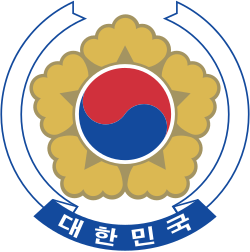1972 South Korean constitutional referendum
You can help expand this article with text translated from the corresponding article in Korean. (November 2022) Click [show] for important translation instructions.
|
| This article is part of a series on |
 |
|---|
A constitutional referendum was held in South Korea on 21 November 1972.[1] President Park Chung-hee had suspended the constitution and dissolved the National Assembly in October. Work began almost immediately on a new constitution. The finished product, the Yushin Constitution, was a severely authoritarian document that dramatically expanded the president's powers and allowed him to run for an unlimited number of six-year terms. For all intents and purposes, the document concentrated all governing power in Park's hands.
According to official figures, the new document was approved by 92.3% of voters, with a turnout of 91.9%.[2] The adoption of the constitution upon the announcement of the official referendum results ushered in the Fourth Republic of South Korea.
Results
[edit]| Choice | Votes | % | |
|---|---|---|---|
| For | 13,186,559 | 92.26 | |
| Against | 1,106,143 | 7.74 | |
| Total | 14,292,702 | 100.00 | |
| Valid votes | 14,292,702 | 99.18 | |
| Invalid/blank votes | 118,012 | 0.82 | |
| Total votes | 14,410,714 | 100.00 | |
| Registered voters/turnout | 15,676,395 | 91.93 | |
| Source: Nohlen et al. | |||
By province
[edit]| Region | For | % | Against | % | Total | Turnout |
|---|---|---|---|---|---|---|
| Seoul | 2,045,941 | 82.5 | 410,474 | 16.6 | 2,479,585 | 80.5 |
| Busan | 772,749 | 85.0 | 127,512 | 14.0 | 909,346 | 93.9 |
| Gyeonggi | 1,508,712 | 92.8 | 104,759 | 6.4 | 1,626,187 | 94.2 |
| North Chungcheong | 621,723 | 92.8 | 35,453 | 5.3 | 662,739 | 94.9 |
| South Chungcheong | 1,213,614 | 93.4 | 74,225 | 5.7 | 1,298,688 | 94.8 |
| Gangwon | 791,608 | 95.8 | 29,715 | 3.6 | 826,398 | 97.1 |
| North Jeolla | 1,015,489 | 93.5 | 61,186 | 5.6 | 1,086,542 | 94.2 |
| South Jeolla | 1,686,340 | 95.1 | 74,741 | 4.2 | 1,773,221 | 93.4 |
| North Gyeongsang | 1,983,081 | 94.1 | 104,873 | 5.0 | 2,108,501 | 95.3 |
| South Gyeongsang | 1,383,424 | 94.4 | 74,981 | 5.1 | 1,466,227 | 95.3 |
| Jeju | 163,885 | 94.6 | 8,224 | 4.7 | 173,280 | 94.9 |
| Source: Kyunghyang Shinmun, 23 November 1972 | ||||||
References
[edit]- ^ Dieter Nohlen, Florian Grotz & Christof Hartmann (2001) Elections in Asia: A data handbook, Volume II, p420 ISBN 0-19-924959-8
- ^ Nohlen et al, p427


 French
French Deutsch
Deutsch